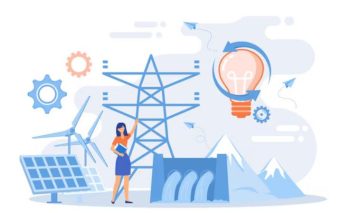
Written By: Chong Chern Peng, Vice President, Huawei Digital Power Business
Transitioning to modern energy systems presents a daunting challenge, as virtually every facet of our daily lives hinges on energy. This journey is bound to be intricate and complex for every country.
Thankfully, there is a resounding global consensus by governments worldwide—including Malaysia’s—that traditional energy systems are inherently vulnerable, disadvantageously centralised, and financially burdensome, and that modern energy systems are the way forward.

Chong Chern Peng, Vice President, Huawei Digital Power Business
The transitional challenge that stakeholders and decision-makers have been grappling with is threefold:
- Striking a balance between environmental sustainability.
- Ensuring energy security
- Delivering energy affordability.
Successfully navigating this “energy trilemma” demands interdisciplinary expertise, effective policy implementation, and unwavering stakeholder commitment if Malaysia is to become carbon neutral by 2050. It also necessitates the use of modern energy systems.
Accelerating Malaysia’s transition towards carbon neutrality and energy sustainability with the power of technology and innovation makes economic sense, and puts us on a path towards a better, greener future for generations to come.
As a technology leader, Huawei is steadfast in its determination to stand by the country’s aspirations in driving this transformative endeavour.
Renewable Energy Makes Economic Sense
The economic rationale for renewable energy is compelling. Jobs in the sector are on the rise. The surge in demand for talent in the renewable energy sector mirrors the urgency to transition to cleaner sources amid the alarming effects of climate change.
According to a report by the International Renewable Energy Agency (IRENA), jobs in the renewable energy sector soared to 12.7 million globally in 2023, reflecting the sector’s rapid expansion and potential for sustainable employment.
The once-perceived barrier of high entry costs to adopt renewable energy technologies is steadily diminishing, heralding a significant shift in accessibility. Put simply, prices are plummeting.
On the other hand, finite fossil fuel source extraction has become more challenging and costs are steadily rising. In contrast, renewable energy, such as solar and wind power, are readily and abundantly available natural resources and more importantly, they are essentially free.
Solar panel prices are at an all-time low and solar photovoltaic (PV) systems are becoming increasingly cost-effective due to ongoing technological enhancements and intensified market competition.
The figures that are clocking in on Malaysia’s carbon footprint read at approximately 272.9 million tonnes of CO2 emissions in 2022. By 2023, Huawei facilitated the reduction of 1.81 million tonnes of carbon dioxide emissions per year. This was made possible by the entry of 2.6 gigawatts (GW) of solar inverters into the Malaysian market, generating approximately 3.9 billion kilowatt-hours of electricity annually.
Huawei’s Digital Power Business contributed to 84.5 billion kWh of green power generation in the Asia Pacific region, reducing carbon emissions equivalent to the planting of 50 million trees.
Technology: Navigating the Trilemma with Modern Energy Systems and Beyond
New technologies, like modern energy systems, are the key to meaningfully navigating the energy trilemma, both to lower the carbon footprint of outmoded energy systems and to develop modern, sustainable alternatives.
The advent of Artificial Intelligence (AI), cloud computing, blockchain, and the Internet of Things (IoT) empowers us to decarbonise our energy systems by enhancing connectivity, intelligence, efficiency, reliability, and sustainability.
“Transitioning to modern energy systems presents a daunting challenge, as virtually every facet of our daily lives hinges on energy. This journey is bound to be intricate and complex for every country. Thankfully, there is a resounding global consensus by governments worldwide—including Malaysia’s—that traditional energy systems are inherently vulnerable, disadvantageously centralised, and financially burdensome.”
Huawei Digital Power’s strategic approach to facilitate society’s transition from high-carbon to low-carbon is anchored in the integration of cutting-edge digital technology (Bit), electronic power technology (Watt), thermal management technology (Heat), and energy storage systems (ESS) management technology (Battery).
Termed collectively as the “4T” technologies (WatT, HeaT, BatTery, and BiT), the aim is to drive Malaysia towards the “4D” trajectory: Decarbonisation, Digitalisation, Decentralisation, and Democratisation. This thus can shape a more sustainable and inclusive energy landscape for the nation.
Huawei aims to drive watts with bits towards building a fully connected smart grid and bridging the energy divide to power the digital world with modern energy systems.
Collaborations in Decarbonisation
In pursuit of the 4D trajectory, collaborations are fundamental. Guided by our strategic framework, Huawei has initiated numerous collaborations with local stakeholders and government agencies on renewable energy projects.
We are partnering with AmBank on financing and merchant business solutions to support and facilitate the introduction of Solar Energy, Green Data Centres, Electric Vehicle (EV) Charging, and Energy Storage solutions to businesses.
With Pantas, the leading climate-tech firm in Southeast Asia, we are collaborating on enterprise decarbonisation applications for businesses. Our focus in this partnership, as technology providers, will be on Smart PV+ESS and FusionCharge solutions while Pantas undertakes the role of strategic partner in business development.
We have also joined forces with Senheng and Apulsar to promote electric vehicle (EV) adoption in Malaysia, utilising Huawei’s advanced EV chargers.
Additionally, our commitment to human capital development ensures a skilled workforce adept in renewable energy technologies. Our Huawei ICT Academy bridges the gap between education and industry needs while collaborative training programmes like the one with the Centre for Technology Excellence Sarawak (“CENTEXS”) on developing green talent as well as the Digital Leadership Excellence Programme with the Malaysian Communications and Multimedia Commission (MCMC) to nurture talent leadership.
These initiatives are but some of the many projects Huawei is involved in. Every initiative represents a positive stride that strengthens energy security and nurtures a sustainable ecosystem for the nation.
Holistic Approach to Carbon Neutrality Goals
Our holistic approach, combining advanced technology, industry partnerships, and education, has the potential to drive meaningful change and accelerate progress towards Malaysia’s 2050 carbon neutrality goal.
By embracing smart PV solutions, grid technologies, energy storage systems, and modern energy systems we can boost renewable energy production while ensuring fair access for all.
By facilitating financing and investments into sustainable energy projects, we can make green technologies affordable for all segments of society.
Just last month (April), the Government of Malaysia announced that it would establish an Energy Exchange Malaysia (ENEGEM) to facilitate cross-border sales of green electricity to neighbouring countries, namely Singapore and Thailand.
This will promote growth in the industry and lead to the adoption of the latest green energy technologies to propel Malaysia into a regional hub for the development of RE experts and capabilities.
In terms of talent cultivation, our training programmes and knowledge-sharing initiatives aim to build a sustainable high-skilled workforce that can lead the transition to future-focused technology (and, more specifically, modern energy systems).
Huawei aspires to lead by example as both a stakeholder and technology provider in addressing the intricate energy trilemma. Achieving carbon peak and carbon neutrality will require the collective efforts of all industry players.
We must create an ecosystem and we all need to be partners as well as players in this ecosystem. Huawei will continue to be a trusted partner and work with our partners across the industry value chain towards a better and greener Malaysia.
 (0)
(0) (0)
(0)Archive
- October 2024(44)
- September 2024(94)
- August 2024(100)
- July 2024(99)
- June 2024(126)
- May 2024(155)
- April 2024(123)
- March 2024(112)
- February 2024(109)
- January 2024(95)
- December 2023(56)
- November 2023(86)
- October 2023(97)
- September 2023(89)
- August 2023(101)
- July 2023(104)
- June 2023(113)
- May 2023(103)
- April 2023(93)
- March 2023(129)
- February 2023(77)
- January 2023(91)
- December 2022(90)
- November 2022(125)
- October 2022(117)
- September 2022(137)
- August 2022(119)
- July 2022(99)
- June 2022(128)
- May 2022(112)
- April 2022(108)
- March 2022(121)
- February 2022(93)
- January 2022(110)
- December 2021(92)
- November 2021(107)
- October 2021(101)
- September 2021(81)
- August 2021(74)
- July 2021(78)
- June 2021(92)
- May 2021(67)
- April 2021(79)
- March 2021(79)
- February 2021(58)
- January 2021(55)
- December 2020(56)
- November 2020(59)
- October 2020(78)
- September 2020(72)
- August 2020(64)
- July 2020(71)
- June 2020(74)
- May 2020(50)
- April 2020(71)
- March 2020(71)
- February 2020(58)
- January 2020(62)
- December 2019(57)
- November 2019(64)
- October 2019(25)
- September 2019(24)
- August 2019(14)
- July 2019(23)
- June 2019(54)
- May 2019(82)
- April 2019(76)
- March 2019(71)
- February 2019(67)
- January 2019(75)
- December 2018(44)
- November 2018(47)
- October 2018(74)
- September 2018(54)
- August 2018(61)
- July 2018(72)
- June 2018(62)
- May 2018(62)
- April 2018(73)
- March 2018(76)
- February 2018(8)
- January 2018(7)
- December 2017(6)
- November 2017(8)
- October 2017(3)
- September 2017(4)
- August 2017(4)
- July 2017(2)
- June 2017(5)
- May 2017(6)
- April 2017(11)
- March 2017(8)
- February 2017(16)
- January 2017(10)
- December 2016(12)
- November 2016(20)
- October 2016(7)
- September 2016(102)
- August 2016(168)
- July 2016(141)
- June 2016(149)
- May 2016(117)
- April 2016(59)
- March 2016(85)
- February 2016(153)
- December 2015(150)
